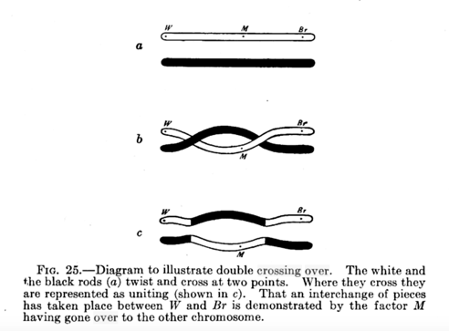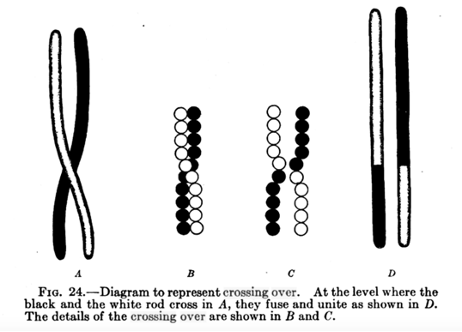Thomas Hunt Morgan and Alfred Sturtevant: Chromosome mapping via linkage analysis
In the early 1900’s, Mendel’s work in pea plants was rediscovered, and several researchers began testing the laws of Equal Segregation and Independent Assortment in other species. Very quickly, exceptions to the rule of Independent Assortment were found in multiple species. William Bateson and Reginald Punnett (yes, that Punnett) observed that in the sweet pea plant, a plant heterozygous for red/blue flower color and round/long pollen shape would produce red, blue, round, and long offspring. But the blues mostly had long pollen, and the reds mostly had round pollen. This matched the combination of traits seen in the parents of the heterozygote[1]. Bateson and Punnett described the coinciding traits as “coupling” and the traits that hardly ever coincided as “in repulsion”.
More examples came from the work of Thomas Hunt Morgan, who observed that sex phenotypes (maleness and femaleness) were linked with other traits not associated with sex (in the fruit fly Drosophila melanogaster, white eyes, yellow body, and miniature wings were all associated with sex)[2]. Because those traits all coupled with each other and with the sex factor for femaleness, and because the sex chromosome was visible microscopically and known to couple with sex, Morgan hypothesized that all three genetic factors were coupled on the sex chromosome and that the rare examples of uncoupling were a result of crossing over, which was also visible microscopically. His drawings of this[3] are illustrated in Figure 7a.


Morgan further hypothesized that the distance between genes could be estimated by the frequency of uncoupled traits since crossing over was more likely to happen if the genes were farther apart. Morgan’s undergraduate student, Alfred Sturtevant, set out to use the frequency of crossovers (what we’d now call recombination frequency) to draw a map of the Drosophila X chromosome[4]. He accomplished this through a series of genetic test crosses like the one illustrated in Figure 8. Morgan and Sturtevant later went on to map additional chromosomes as well.
Media Attributions
- Internal patch of exchanged © The Mechanism of Mendelian Heredity, by TH Morgan, via Google Books is licensed under a Public Domain license
- Diagrams of crossing over © The Mechanism of Mendelian Heredity, by TH Morgan, via Google Books is licensed under a Public Domain license
- Bateson, William, Punnett, Reginald C. On the inter-relations of genetic factors. Proc. R. Soc. B 84, (1911). ↵
- Morgan, T. H., Sturtevant, A. H., Muller, H. J. & Bridges, C. B. The Mechanism of Mendelian Heredity. (H. Holt and Company, 1923). ↵
- ibid ↵
- Sturtevant, A. H. The linear arrangement of six sex-linked factors in Drosophila, as shown by their mode of association. J. Exp. Zool. (1913). ↵

